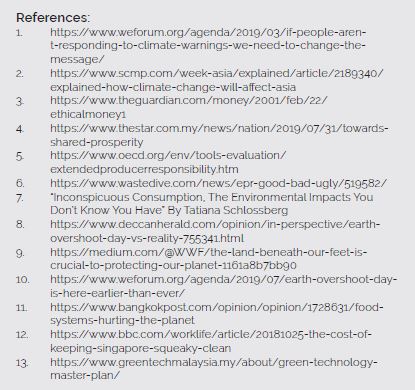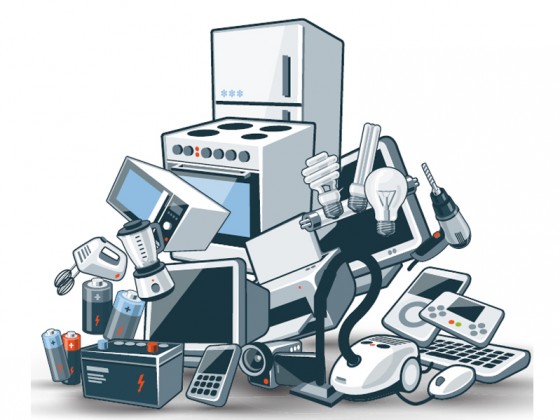by | Mohd Hasan Mohd Saaid, hasan@might.org.my
Today, we live in a world facing dire threats from environmental degradation and climate change. To some extent, climate change’s effects have become more obvious by the day. So much so, some countries have to confront serious national safety concerns where rising seas threaten to wipe them off the map entirely. For example, Fiji’s Prime Minister, plans to move 40 Fijian villages in the coming years to resist the assault, which globally climbed about 7.5 inches in the 20th century and could rise 3 feet more by the end of the 21st century, according to the U.N.’s climate-science arm.
Still, Asia is regularly identified as one of the regions that will be hit the hardest by global warming. The UN Framework Convention on Climate Change noted that Asia’s large population, frequency of natural disasters, and a sometimes chaotic process of urbanisation, with population relocation to coastal cities, as some of the factors that make Asia especially vulnerable to the unrelenting risks of climate change.
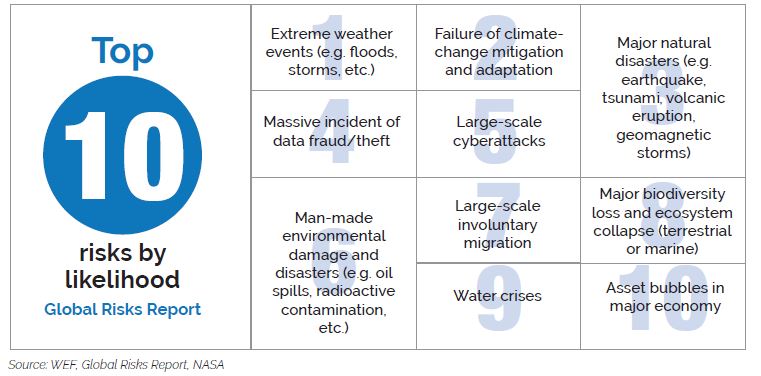
Sense of urgency
Scenarios are a powerful tool to motivate firm action in order to address looming threats. Like a vision, a clear image of the future projecting how climate change can significantly impact the environment can be a spur to action. As such, behavioural psychologists explain that the underestimation of climate risks is in part a consequence of the low emotional engagement evoked by the risks.
Climate risks seem too far away in both space and time to trigger the feeling of risk, and it is this feeling that causes us to take precautions. New research finds that people perceive risks to be higher when they can easily bring to mind a picture of the event. With this in mind, images of threats need to be communicated to the public with the adoption of behavioural insights.
The World Bank predicts that if action on waste is not taken, waste could grow 70% by 2050, jumping from 2 billion tonnes in 2016, to 3.4 billion tonnes in the next 30 years according to “What a Waste 2.0: A Global Snapshot of Solid Waste Management to 2050” report.
With growing pressures on ecosystems, the world’s success in tackling environmental issues has been dismal. In the last quarter of the century, rainfall patterns have dramatically changed to a point where water scarcity is looming large. Natural disasters are occurring at a far higher frequency than ever. Organisms are rapidly developing resistance to antibiotics and humans are helpless in the face of this onslaught.
A special report on climate change and land by the Intergovernmental Panel on Climate Change (IPCC) states that the way we use land drives climate change. Human activities in agriculture, forestry and other land uses are a big source of human-induced greenhouse gas emissions which is around 23% of the global total. Thus, this makes it one of the biggest drivers of climate change. Reducing emissions from land can be a big part of the solution.

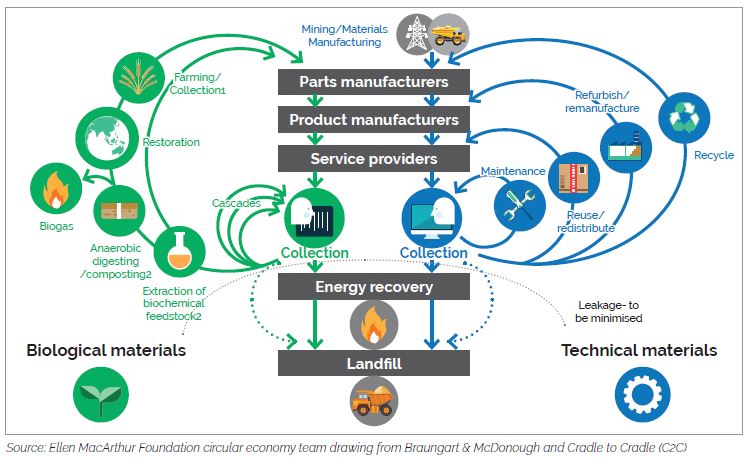
Ethical consumption
The big question is—how can we infuse a culture of green mindset and ethical consumption? At the same time, the question also holds some significant answers to the problem as a source of salvation. It’s a role that must be played by both producers and consumers. In a circular economy as illustrated below, tackling environmental issues must begin with thinking of resources. Can resources be renewed or replaced by better alternatives?
As consumers, try to think about this; Netflix uses up to 15% of all the internet bandwidth on earth; shoppers return 35% of the goods they buy online, which is as much as six times more than when they shop in stores. Producing polyester for clothes emits as much carbon dioxide as 185 coal-fired power plants; a single fleece garment can shed 100,000 plastic microfibers in one washing.
July 29 marked the Earth Overshoot Day for 2019. Earth Overshoot Day (EOD) or previously known as the ‘Ecological Debt Day’ marks the time of year when we have consumed all the resources that this planet could have provided for that year.
At this rate, it would take 1.75 earths to sustainably meet the current demands of humanity, according to a UN data. Meanwhile, consumers’ role in consumption must be tackled in terms of the products they buy, their consumption behaviour and how their consumption is disposed.
But who should be responsible for the life cycle of a product, especially its take-back, recycling and final disposition? In 1990, Thomas Lindquist first introduced a concept in Sweden where he proposed that product manufacturers and distributors should be responsible for the life of their products and packaging after consumers are through with them. Wasted food has a shockingly high impact. We don’t consume 25–30% of total food produced which results in 8–10% of total human-induced greenhouse gas emissions.
Global mission
In achieving sustainable consumption, the United Nations (UN) through its Sustainable Development Goals (SGDs) effort, places a specific goal in tackling consumption in Goal number 12;
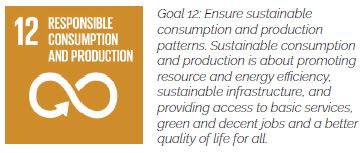
Gearing Malaysia toward sustainable consumption
Malaysia’s vision for 2030 or better known as Shared Prosperity Vision 2030 intends to ensure every rakyat enjoys economic prosperity in a fairer, equitable measure.
Currently, Malaysia is articulating an action goal toward shared prosperity. To this end, tackling environmental issues is crucially beneficial to the society’s overall wellbeing. Therefore, its Green Technology Master Plan has outlined the nation’s commitment in addressing its economic and population growth. It seeks to heighten pressure concerning the nation’s depleting resources and impact on the environment.
Here is a quick give on Malaysia’s target as highlighted in its Green Technology Master Plan:
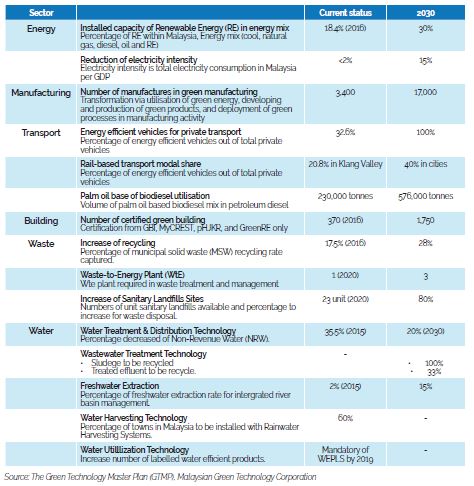
Policy implications
• While most of us have been focusing on the energy and transportation sectors in the climate change fight, we cannot ignore the role that our food production has on cutting emissions and curbing climate change. Thus, the government needs to rethink how to shift public behaviour on consumption.
• In policy transition, governments can move their policy adoption from a voluntary approach to a compulsory requirement. In 1963, the Singaporean government imposed strict regulations to get a handle on how its citizens dispose their waste. In effect, the high fine exerted positively resulted in low waste litter. The country’s first Prime Minister, Lee Kuan Yew kicked off the Keep Singapore Clean campaign some 50 years ago and now the government still uses fines as a method of social control.
• Sustainable policy should not stop at extended producer responsibility (EPR). Governments must encourage adoption of technology and sustainable new business models. Technology can make manufacturing processes more flexible, allowing higher product customisation by consumers. Nike, for example, offers online services that allow customers to design some aspects of their own shoes. The Internet of Things (IoT) can aid in the production process by analysing machinery and goods and ensuring that the process is run optimally. Logistically, IoT can help producers track goods during transit. AI and machine learning can aid product forecasting and increase efficiency during production. It also enables predictive recommendations and deliveries. In addition, robotics can be utilised in various ways. Robotics increases production efficiency and can be used in various customer service scenarios. Digital traceability can aid in logistics by tracking goods all the way from raw materials to finished products.
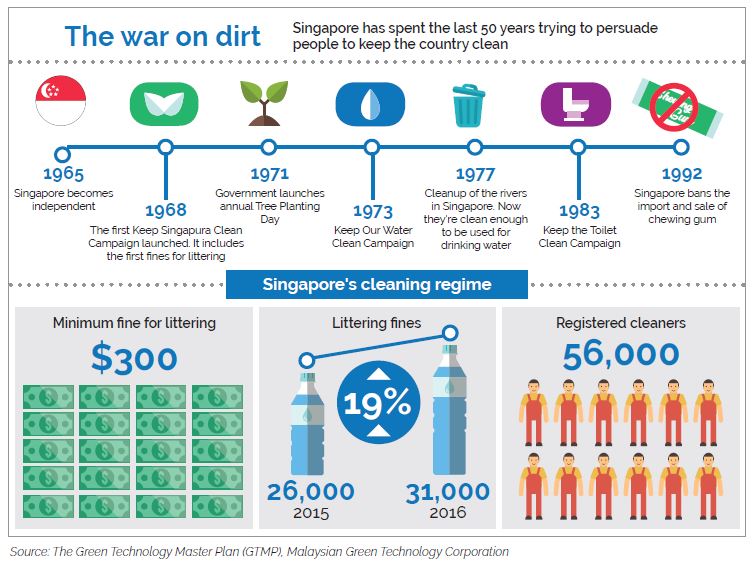
Business implications
• EPR has been adopted by big corporations like Coca Cola, McDonalds, Samsung and Huawei. Companies are required to be responsible for the collection, treatment and disposal of their products after they’ve been used, helping to reduce waste and create a market for discarded plastic, paper and metal that would otherwise be destined for landfills.
• In this case for example, McDonalds has ordered a ban on plastic straws, while Huawei collects back e-waste with incentive. Businesses can take this opportunity to produce alternatives of plastic straws.
• If environmental issues are taken seriously, perhaps by reducing waste and emissions during production, producers will appear more favourable to consumers and are more likely to build consumers’ trust and loyalty.
• Businesses could make or adopt technological advances in the way we use and reuse materials. Businesses could avoid unnecessary travel by using modern communication methods. Moving materials around the planet will be more difficult and one way to get around this is by doing more with 3D printing. Adopting traceability technology like blockchain could provide information for consumers to buy based on the history of the product.
• The diverse nature of the trends driving consumer change will require companies to manage increasingly complex issues. “Business as usual” is an approach that is unlikely to work any longer for consumer goods producers.
• As consumer interest in customised products grows with the technology that will make the manufacturing of those products easier and cheaper, companies will need to continually invest in both product and process innovations.
• Collecting consumer data from sources like Google and Facebook will not be enough when determining what consumers want. Companies will need to actively engage with consumers and actually listen to them. This type of outreach could enable producers to shape consumer trends, not just react to them.
• Building trust with consumers requires more than public relations effort; transparency and ethical corporate behaviour are particularly important for consumer goods producers and retailers. Negative publicity can lead to boycotts and other consumer actions that can permanently damage a brand.
• Rapid innovations across all aspects of business are essential for consumer goods producers to remain competitive.
Society implications
• The society and its citizens need to foster a fundamental shift to promote a better way of consuming products and services. We can lessen the impact on the environment and reduce greenhouse gas emissions significantly by adopting a new green lifestyle.
• In terms of food, wastage must be reduced. Consumer preferences must change and farmers must be educated to adopt ecologically sustainable practices. We need to do more about learning to live sustainably. The society needs to reduce overall demand—and that ultimately means changing our consumption behaviour and lifestyle.
